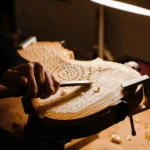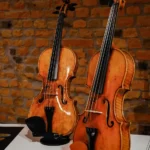The Violin: Age, Origin, Value, and Appraisal
Back to BlogThe Violin: Age, Origin, Value, and Appraisal
The violin seems to be just another musical instrument to many, but the passionate ones understand it is a quality instrument. According to Allied Market Research, the demand for violin is soaring due to the increasing demand for learning new skills and availability. Besides that, believe it or not, the stringed instrument benefits your cognitive abilities, too, which further escalates your memory, attention, fine motor skills, and spatial-temporal. If these studies motivate you to purchase the musical instrument, or in case you are already a violin lover, then keep the initial evaluation, age, provenance, value, and certificate of an old violin in mind so you don’t regret your impulsive buying later.
How To Initially Evaluate The Age, Provenance, Value, and Certificate Of An Old Violin?
The curvy wooden stringed instrument grabs the eyes of those who truly understand the finesse that goes into manufacturing this mass-produced musical instrument. However, if you are new to this domain, then you should be aware of how the initial evaluation age provenance value and certificate of an old violin determines the violin’s worth. The following things have to be taken into consideration:
Initial Inspection: A Thorough Look
Once you enter a violin shop, you won’t just place your finger on the first violin placed in front of you. You will take a thorough look at the musical instrument to confirm whether the instrument is worth your capital or not. When talking about old violins, you will access the following factors:
Entire Condition
Analyze the entire condition of the stringed instrument. Search for spots that need repair, cracks, or prominent parts whose absence can negatively impact the working of the violin and its value. Request a condition report so you can be aware of any condition the instrument may have at the moment or had already been repaired.
Markings and Value
Check for the label of the maker’s name, the date, and the place of origin when accessing the musical instrument. Why? These three things increase the value of the violin. However make sure to ask about the label to the owner of the shop as sometimes the label does not correspond to the maker who did it. Therefore, make sure that you know who crafted it, when, and where it was created.
Certificate of Authenticity
Always ask for its certificate of authenticity from a reliable expert. In case it is a new instrument, ask for the maker’s certificate of authenticity. Having an old violin with a reliable certificate of authenticity will support your purchase.
Varnish and Color
What is the color of the varnish? Observe the shade of the varnish and its condition. A richer patina is developed on the varnish with age, but restoration and heavy wear can significantly affect its value.
Digging Into The Constructive Details
The measurements and details of the musical instrument will interfere on the playability so make sure to choose accordinto to your playing style.
Measurements and models
What violin size do you require? Or model you are interested in? every maker has its own style and different models they used to work on. Also there are some makers with golden periods of work, which means in this specific period range their work values more than another period and this has also to do with the craftsmanship and model done.
Design of the Scroll
Have you ever observed the intricate carving on the top of the neck of the violin? Yes, that is the scroll. The scroll can enlighten the buyer, that is, you, about its maker and the period in which it was crafted. If interested, then you can even look up on the internet and do extensive research related to different scroll designs representing various violin-making schools.
F-Holes and Scroll Design
The F-holes, as well as the scroll are of a variety of designs and represent different eras, from which a violin maker can easily identify which artist played their role in constructing the violin.
Do Some Research and Have Relevant Reference Materials
Stepping into the world of violins, you must do some research to learn about the many prominent schools that are recognized for making quality instruments. Apart from that, lay your hands on relevant research materials:
Renowned Famous Schools
For instance, the renowned ones are Cremonese, Milanese, Venetian and NApoletan with names shining bright like Stradivari, Amati, Guarneri, Gagliano, Grancino, Goffriller and many others. Even if you are not into violins, then you must have heard the name Stradivari.
Lay Your Hands On Relevant References Online and Offline
The internet is a broad landscape that has unlimited information on every topic. Violin is not behind in this race. Therefore, lay your hands on relevant references like books that carry detailed and important information about the greatest violin makers in history, what ideal violins they crafted with descriptions of each and every quality instrument that existed in that era, and the maker, who received every bit of acknowledgment.
The Role Of Provenance
Provenance means the history of ownership. In the case of violins, when it’s time for the initial evaluation, provenance plays a pivotal role. History determines the desirability and value of an old violin in the following ways:
Increase of Value
If there is heavy documentation behind a violin, holding the name of the actual carrier, like who owned it previously, can take the violin’s value to the next level. Owning a violin previously played by influential figures, violin experts, or holding relevant records, makes the violin stand out from other instruments. Receipts and appraisals boost the value of the instrument.
Certificates of Authenticity
You don’t buy anything without certificates that prove the authenticity of the product. Violins, too, fall in the same category. The certificate adds credibility and trust to the musical instrument that you have picked as a genuine masterpiece. In the case of the violin, a certificate from a reliable expert will give you peace of mind that you did not purchase the wrong violin.
Conclusion
Are you ready to buy a high-quality violin and don’t know about a good violin shop? Head over to Amorim Fine Violins, where you will not regret paying a visit. The shop is equipped with the finest violins and has never left any of the clients disappointed by the quality.









